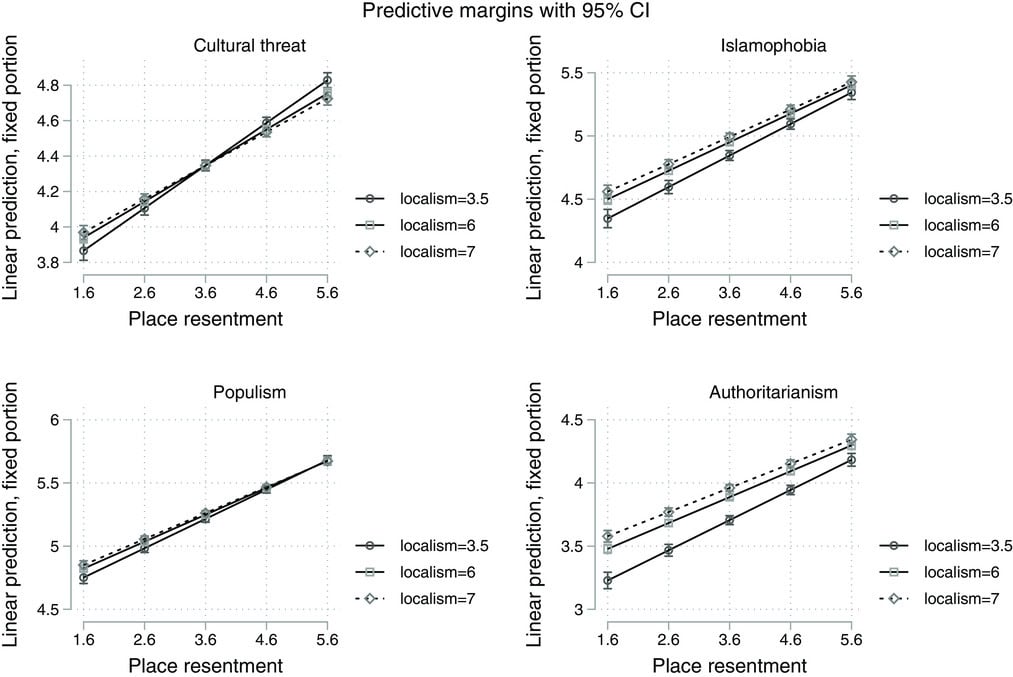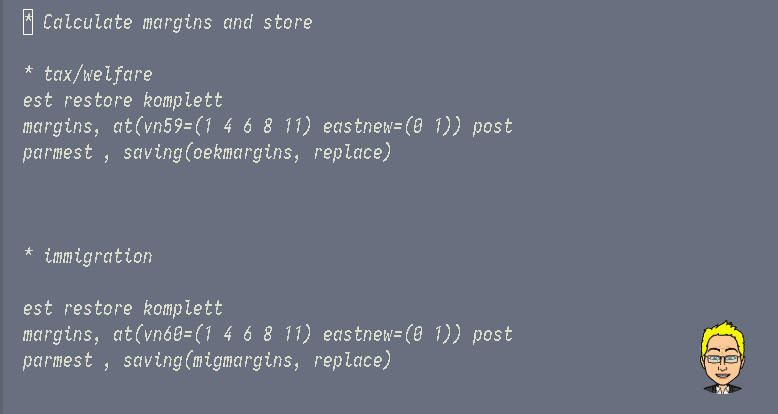Stata’s margins command can be a bit confusing
Stata’s margins is a postestimation command which does all sorts of amazing things. Margins is incredibly powerful, and the accompanying marginsplot command nearly always does just the right thing.
Margins and marginsplot have almost singlehandedly changed the way people interpret the way model estimates (particularly estimates from nonlinear and/or interactive models) for the better. “Almost”, because before margins there were similar commands (most notably Long & Freese’s original SPost), but margins is way better.
And yet, it seems that my students and I are not the only ones who are occasionally baffled by margins.
Stata Corp. provides excellent documentation for margins and marginsplot, but at a little over 60 pages (not counting the remarks on margins post-estimation), the manual entry on margins alone is a little overwhelming. And there are just too many options, which contributes to the general bafflement. More specifically, there are two separate issues that seem to confuse a lot of people (see this discussion on statalist on the then-new margins command).

Marginal Effects at the Mean vs Average Marginal Effects
The first is that in the (ever more distant) past, when studying the implications from nonlinear (e.g. logit) models, many people including me used to analyse “marginal effects at the mean“. In short, this boils down to holding most independent variables constant at their grand means/modes while plugging a range of hopefully relevant values for one or two focal variables into the equation. This approach, which was pioneered by J. Scott Long, is easier to understand than to explain and greatly aids the interpretation of non-linear models.
Margins can (amongst many other things) estimate marginal effects at the mean. But unfortunately, this often results in very unrealistic scenarios if your independent variables are highly correlated (think of holding age constant at its mean whilst simultaneously varying pensioner/non-pensioner status).
Therefore, looking at “average marginal effects” often makes more sense. These are calculated by varying the focal variable while holding everything else at the observed values. This is what the margins command does by default. Michael Norman Mitchell has a post (since removed, but thankfully preserved by the internet archive) that clearly illustrates the differences between the two approaches to the estimation of margins. If you are ready for a somewhat deeper dive, Richard Williams’ 2012 article on Using the margins command to estimate and interpret adjusted predictions and marginal effects is a modern classic and a masterclass in didactics, free for you to read at this URL. Moreover, there is an older article by Tamás Bartus on his (now obsolete) margeff command that is also quite instructive.
Another problem with understanding what margins (the thing) and margins (the command) are about is that the terminology varies wildly within and across disciplines. In this respect, I find Williams’ definitions and explanations particularly helpful.
Dubious Confidence Intervals
But one problem remains: margins uses a normal approximation for calculating confidence intervals. As a result, after estimating a model for categorical dependent variables, you might end up with a CI for your margins that includes zero, which obviously does not make much sense. Roger Newson seems to know how to get around this issue. So far, I haven’t used his approach, but it looks plausible enough.
Summary
Margins and the marginsplot command are incredibly powerful tools. My students have been conditioned (geddit? geddit?) to resort to margins whenever we encounter interactions and nonlinearities. If you want to get an idea what margins can do for you, there are a lot of tutorials on the internet to work through. The Stata blog has a lot of interesting material, but the posts are probably not the best point to start. Instead, one could try this presentation by Richard Williams, which is based on the article mentioned above, or the even shorter intro to margins and marginsplot at UCLA’s always useful resource page. And Nari Yoo has another short intro to margins, with additional links.
And if you would rather use R than Stata, margins and marginsplot have been partially ported to R, but I do not know if these packages are as good as the original. See Will’s extensive comment below – again, this looks very interesting.
Discover more from kai arzheimer
Subscribe to get the latest posts sent to your email.





Missing a word here, I think?
“I take it that they have been partially ported to R”
They have been extensively ported to R in the marginaleffects package (a successor to the margins package), with uncertainty available from delta method, (cluster) robust, simulation and bootstrap methods. The package comes with an online book full of case studies and explanations. Available here:
https://marginaleffects.com
Thanks Will – this is very helpful!
Vaya, ya te hicieron visible – parecía que Elon Musk te hubiese enviado en un SpaceX a Marte.😀
Hey Kai, looks like the Facebook SocialSync is working great on your site! 🙂 Very happy to see that! Pumped to have you using Livefyre. Welcome to the community!
Thanks Ben – very useful indeed
I’ve found this http://www.nd.edu/~rwilliam/xsoc73994/Margins01.pdf and this http://www.nd.edu/~rwilliam/xsoc73994/Margins02.pdf pretty useful.